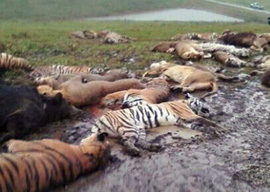
October 25, 2011

“Uh, there’s a lion…standing there under the streetlight,” the 911 caller told the Ohio dispatcher. Another caller declared, “I think I’ve just seen one. Looked like a jaguar or a wolf or something.”
These lines sound as if they were lifted from Charles G. Finney’s subversive 1935 novel The Circus of Dr. Lao, which tells the tale of a very unusual traveling show filled with werewolves, sea serpents, and a dog made of chlorophyll. One day this circus arrives in the tiny town of Abalone, Arizona, where it parades through Main Street before setting itself up in a nearby field. Throughout the book there is a running joke swirling around a hairy beast in a cage: “It’s a man.” “No, it’s a bear.” “It’s a Russian.” The strange overlapping of identities underscores the known problems of eyewitness testimony, as well as difficulties of sustaining a sense of wonder in a small-minded century.
Inside the story’s strictures, Dr. Lao’s circus is real. According to all other parameters of reality, so was the Muskingum County Animal Farm of Terry Thompson, who last week covered himself with chicken parts, let his wild animals loose, and then killed himself. Newly freed, the lions and tigers and bears went running into the streets of the aptly named town of Zanesville, Ohio, and started casting come-hither looks on street corners, brazenly shocking the neighbors. Fox News made sure to emphasize that these were “wild and dangerous” animals that made for a “frightening and tense” day in Small Town, USA, with the good sheriff declaring that “public safety” was his top priority. The ASPCA intoned, “Schools were closed. Businesses shut down. And the majority of residents stayed locked in their homes….” BBC News quoted the sheriff as saying: “We didn’t want kids waiting by the bus stop and seeing these big animals.” The next morning, forty-nine animals were dead, but not from indigestion or spitballs. Using duty pistols, law-enforcement officers had shot to death two wolves, six black bears, two grizzly bears, 17 lions, one baboon, three mountain lions, and 18 Bengal tigers.
Such animals are TV stars on the Discovery Channel and Animal Planet, wild carnivores that the Western world has invested with glamour, sexual power, and complex mythologies. It was thus shocking to see the videotaped footage of so many large lions lying dead on the grass, reduced to pure objects without food value because their carcasses were not correctly prepared. The cameras did not rest on (lifelike) taxidermied specimens, hunting trophies, or handsome actors shot through filters to appear as seductive as possible. Deflated of narrative, the animals were just limp casualties of civilization. They weren’t even covered up as human victims are covered to show respect for the dead. They were exposed like the bodies of fallen enemies in battle. I saw the bodies over breakfast courtesy of Fox News.
During the French Revolution, debauched aristocrats were accused of letting wild animals loose to “devour the spectators” and sow the seeds of fear. This was perceived as a cynical political ploy to distract people from the Revolution’s goals. Last Tuesday, it was a mad collector of guns, guitars, and wild animals who released the beasts, letting loose equally vague but powerful fears into the global consciousness. As spectators watched with horrified fascination, the news of these animals’ deaths traveled around the world. It is perhaps not without interest that Charles G. Finney was a journalist and The Circus of Dr. Lao was published during the Great Depression. In times of sustained financial crisis, there are a lot of reasons to be afraid.
The Circus of Dr. Lao refused to explain how or why this peculiar collection of animals came to Abalone. The story of the Zanesville animal incident also leaves many questions unanswered, but only if it is framed as a whodunit. Instead, it has been narrated as a fable of marvels and madness, with a terrible lesson attached if one cares to learn it. Does it matter that none of the wild animals attacked? The issue isn’t whether they could, but that it was assumed they would.
Throughout human history, wild animals and humans have long lived in proximity, for the most part in a kind of wary agreement to live and let live—as long as human needs take priority. Humans domesticated the animals that they could, and called the others “wild.” When wildness asserts itself in the street, the consequences are severe: dogs that bite humans are destroyed as threats to human safety, but also because they defy those laws that make civilization possible. The more fragile those laws become, the greater the need to enforce them. But for the same reason, the use of lethal force smells of desperation.
There is a parable here regarding the political uses of fear. For in the final calculus, it is forty-nine animals dead and one man by his own hand. The media version of the story concludes with the six survivors now living happily in the Cleveland Zoo. They did not appear on television.